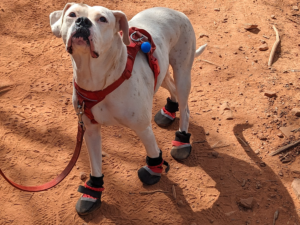
Falkor, an 8-year-old boxer visiting from Vancouver, Canada, is wearing protective booties during a hot weather hike. Photo Courtesy of Carol Dores.
Dogs and children are more at risk for heatstroke than adults. When it is 90 degrees outside in Sedona, it does not feel that bad, because it is dry heat. However, the ground temperatures are 140+ degrees. This radiant ground heat means that dogs and children experience the higher temperatures much more than adults.
While hiking, dogs have direct contact with the super-heated ground and the hot temperatures can burn their feet. Protective booties that are ventilated for heat should be worn. If the dog cannot wear protective booties, they should not be out on the trails in hot weather and should be left in a cool, safe place – not a car! Unlike humans, dogs only have sweat glands on their paws, and must rely on panting to cool down. They need to have plenty of water breaks. When overheated, dogs will lie down and refuse to walk. It is not unusual to see owners carry their dogs out from a hike on a hot day.
“Heatstroke is a life-threatening condition that occurs when the body’s temperature rises too high and cannot be cooled effectively. This can cause severe damage to body organs and can result in death”. (Cornell College of Veterinary Medicine, Heatstroke, A Medical Emergency).
Signs of heatstroke in dogs include heavy panting, drooling, bloody diarrhea and vomiting. Signs of heatstroke in humans include confusion, altered mental status, slurred speech, loss of consciousness, hot, dry skin or profuse sweating, seizures, and very high body temperature.
To prevent heatstroke,
- Wear loose fitting, lightweight clothing.
- Protect against sunburn.
- Drink plenty of fluids.
- Take extra precautions with certain medications (check with your doctor).
- Never leave anyone including animals in a parked car.
- Take it easy during the hottest parts of the day.
- Get acclimated.
- Be cautious if you’re at increased risk.
Summer Sedona Hiking
Devil’s Bridge is one of the most popular hikes year-round, especially with dogs and children. During the summer, ground temperature of red rock silt is even higher than asphalt and the road to Devil’s Bridge offers minimal shade and is extremely hot. It is safer to use the Mescal or Chuck Wagon trails to hike to Devil’s Bridge.
“The Crack” at the end of Bell Trail is a popular summer hiking destination because it provides a natural swimming experience. Locals, visitors, and day trippers from Phoenix often arrive late morning and early afternoon and hike at the hottest time of the day. The hike has little shade and rock walls that reflect heat. Many underestimate the impact of a 7+ mile round trip hike and extreme exposure to sun and heat.
This lack of preparedness often leads to medical emergencies and assistance calls to the area’s first responders. In an effort to reduce these calls, and the strain it puts on local fire, police, and search and rescue organizations, the Forest Service and Friends of the Forest initiated a program to better inform hikers. The initial program was based at Bell Trailhead and expanded in 2022 to Dry Creek Trailhead near Devil’s Bridge.
Friends of the Forest volunteers help hikers be better prepared or choose alternative hikes. In 2022, over 7,800 people were met on the way into the trails. Of those, one in seven altered their plans based on information provided by FOF volunteers.
David Terrell, Friends of the Forest Volunteer, shared, “My Preventative Search and Rescue experience allows me to meet so many interesting people visiting our town, and to help them enjoy their experience safely. Knowing our work helps them and helps our first responders avoid the risks associated with rescues is very rewarding.”
People were extremely appreciative of the help. “The number one comment we heard was ‘thank you for being there,” said Dale Evans, FOF Trail Patrol Chair. “We also heard a lot of ‘I should have listened to you’.”
“A significant number of people go get more water or choose an alternative destination. Those heading out are more aware of the environment and their personal condition,” Evans said. “Bottom line, these volunteers are having a major impact on serving the hiking public and local first responders.”
Want to be part of a team helping to do preventative search and rescue during the summer months? Friends of the Forest is looking for more volunteers.
Training will be in early May. New volunteers are paired with experienced ones. Volunteering will be Saturdays, Sundays and holidays May 27-September 4. At least two volunteers will be on each shift (10 AM – 2 PM).
Want more information about volunteering or Friends of the Forest? Visit www.friendsoftheforestsedona.org.
Serving Sedona, written this week by Carol Dores, Friends of the Forest, appears Wednesday in the Sedona Red Rock News.